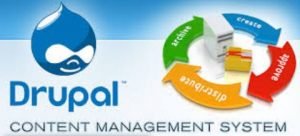Introduce Drupal Content Management System
Introduce Drupal Content Management System

Drupal
Introduce Drupal Content Management System - In its easiest type, a CMS is a software package that gives devices for authoring, publishing, as well as managing content on an internet site. "Web content" consists of anything from a newspaper article, a blog post, a video, or a photo, to a podcast, an article, or a summary of a product that you are marketing. In more basic terms, material is any type of mix of text, graphics, pictures, sound, and also video clip that represents something visitors to your website will read, see, as well as listen to.
A CMS typically gives a variety of attributes that simplify the process of building, releasing, and also managing web sites, including the following:
- An administrative interface
- A data source repository for material
- A rich interface to associate web content that is kept in the data source with a web webpage on the site
- A toolset for authoring, posting, and taking care of content
- A part for developing and also handling food selections and navigational aspects
- The tools called for to specify as well as apply styles
- Individual administration
- A safety and security framework
- Taxonomy as well as marking to organize material by category
- Online forms
- Shopping capacities
There are hundreds of CMSs readily available. They range from basic blogging-centric systems, such as WordPress, to complex enterprise-class material administration services, such as Drupal.
What is DRUPAL?
Drupal
Drupal is a complimentary and also open resource CMS written in PHP and dispersed under the GNU Public Certificate. Drupal stems from a job by a Dutch college student, Dries out Buytaert. The objective of the project was to supply a mechanism for Buytaert and his friends to share information and also occasions. Buytaert transformed Drupal right into an open resource task in 2001, and also the community conveniently welcomed the idea and also has expanded on its modest starts, creating exactly what is now one of the most effective and also feature-rich CMS platforms online. Individuals, groups, and also communities utilize Drupal's attributes to easily publish, handle, and organize material on a selection of website, varying from individual blogs to big company as well as government websites.
The common launch of Drupal, called Drupal core, consists of basic attributes that can be made use of to create a classic sales brochure internet site, a single- or multi-user blog site, a Net discussion forum, or a community web site with user-generated material. Features discovered in Drupal core include the ability to author and also release content; to create as well as handle individuals, food selections, and discussion forums; and also to handle your website with an internet browser-- based management interface.
Drupal was designed to be enhanced with new attributes and customized behavior by downloading as well as allowing add-on components. There are countless extra modules (known as added or "contrib" modules) that prolong Drupal core's functionality, covering a wide spectrum of capabilities, consisting of e-commerce, social networking, integration with third-party applications, multimedia, and also various other groups of capacities.
Drupal could run on any kind of computing platform that sustains both a web server with the ability of running PHP variation 5.5.9+ (consisting of Apache, IIS, lighttpd, and nginx) as well as a database (such as MySQL, SQLite, or PostgreSQL) to keep content as well as settings.
Posted from my blog with SteemPress : https://steemit-help.com/introduce-drupal-content-management-system.html